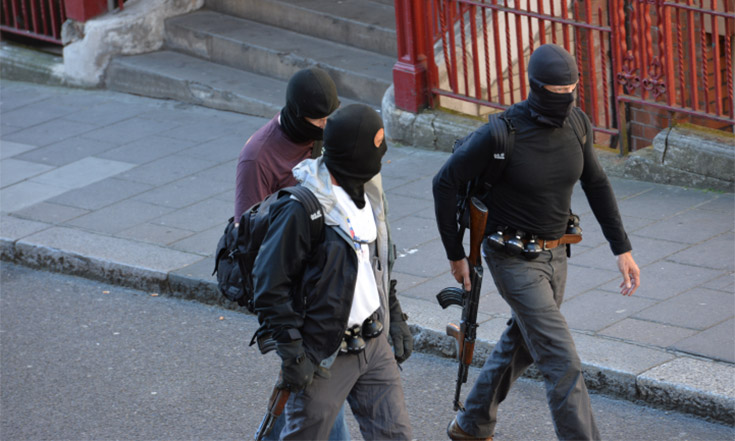Factoring social media into crisis planning and exercising
When you are planning for how you’re going to cope with an emergency, or when you’re in any kind of exercise scenario, you’re not simulating reality if you’re not factoring in social media, says Lorraine Homer

Operation Strong Tower in London earlier this year also simulated the pressures of 'broadcast terrorism'
There are many different types of crisis, but few are as serious as those that occurred in Paris on November 13, 2015. This and other recent terrorist attacks have underlined that almost any organisation, any business, any venue, any event, in any country, is now possibly a target.
We’re entering a new landscape where focusing efforts on protecting critical infrastructure, national events and assets is no longer enough. In Paris, it was a sports event, a concert venue, small bars and restaurants.
CEOs and operations managers in every sector should be questioning their heads of security about the state of their organisation’s crisis management plan, and when it is going to be tested.
But something else Paris underlined is that the way an attack plays out is now fundamentally affected by media, and social media in particular. When the London attacks of 7/7 took place, it took time for the horror experienced by people in the tube carriages and on the bus to come out. Some of it never really has.
As the events in Paris unrolled, people who were trapped, injured, or held hostage inside the venues were on Twitter, Instagram and Facebook, begging for help. They posted images of helpless people dangling from windows trying to escape, and videos of gunfire and screaming, and people dragging their bleeding friends through the street.
This is a real-time climate of broadcast terrorism. It creates an irresistible pressure which challenges, changes and potentially forces the decision making of the most senior people.
This was simulated during Exercise Strong Tower, the Tier 1 counter-terrorism exercise in London in the summer (see CRJ 11:1 for full report)
Whilst not the same scenario as Paris, the exercise had many common features, including a multi-site attack, use of automatic weapons, hostage situations, and significant use of social media by eyewitnesses, hostages and victims’ families.
The media element of the exercise used social media to apply pressure on decision-makers. The media system was on the desk of every senior player, was centre-stage at major meetings, and even drove the decision-making of Ministers at COBR.
The Metropolitan Police Service, the lead agency for the exercise, understands that social media is a game-changer. This is an organisation that can deal with more crises in a week than many organisations have to face in a year.
So it simulated what reality is now: mass use of social media, and its subsequent influence on decision-making and how it drives external factors though both its immediacy and the ability it has to change events, not just report them.
Research by Deloitte found that 1.25million smartphones are sold every fortnight in the UK. Three-quarters of adults have a smart phone; 95 per cent of them use their phones to take photos and two-thirds share these on social media sites.
This tiny piece of kit that fits in your pocket has turned everyone into a cameraman, a journalist, a broadcaster, and a network.
People are no longer reliant on traditional news channels to tell them what is news or decide what they see. They can make their own news – or more precisely, their own version of events – and they can choose what information they get, who they get it from, and who they share it with. Forget official sources. During a major incident, there are now more sources available than anyone could hope to look at in a lifetime.
This was evident in the 2013 murder of Fusilier Lee Rigby, whose killers used the smartphones of witnesses to broadcast their message, knowing full well it would be recorded and shared on social media in minutes.
It was evident in the attack at Leytonstone tube station, where a video of a comment made by a bystander created one of the most iconic phrases of 2015: “You ain’t no Muslim, bruv”, which was quickly turned into #youaintnomuslimbruv on Twitter, used more than 100,000 times over a single weekend and seen and heard by millions.
So people Tweeting “They are executing us one by one” from inside a venue changes the way an incident is handled. It also influences the perception of how an incident is being handled, something that’s critical when you are trying to reassure people and show you are in charge. And the sheer amount of unconfirmed or misinformation and the speed at which it travels will also have an impact, operationally and reputationally.
Organisations need to think again, and quickly, about their crisis management plans.
When you are planning for how you’re going to cope, or when you’re in any kind of exercise scenario, you’re not simulating reality if you’re not factoring in social media.
You might have a great exercise, but when you come to deploy your plan in real life it won’t work if you haven’t planned for the way in which social media changes these events.
You’ll be creating analogue plans for a digital event.
Lorraine Homer is the Director of Nightingale Consultants which specialises in security and crisis communication strategy and response. She was the senior communications advisor to the Metropolitan Police Service for Exercise Strong Tower; find her on Twitter @misslhomer
Lorraine Homer, 14/12/2015